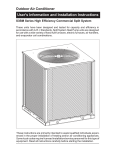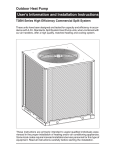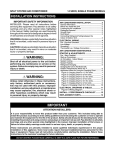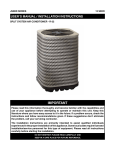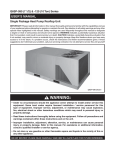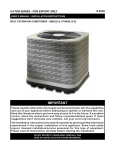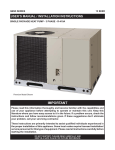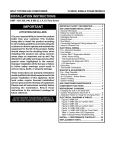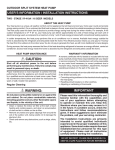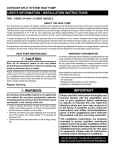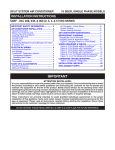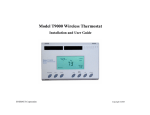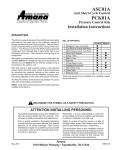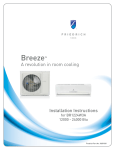Download 709008-A S3BM-120G Split System User manual.indd
Transcript
Outdoor Air Conditioner USER’S INFORMATION AND INSTALLATION INSTRUCTIONS S3BM-120G High Efficiency Commercial Split System IMPORTANT Read this owner information thoroughly and become familiar with the capabilities and use of your appliance before attempting to operate or maintain this unit. Keep this literature where you have easy access to it in the future. If a problem occurs, check the instructions and follow recommendations given. If these suggestions don’t eliminate your problem, call your NORDYNE Servicing Contractor (Service PRO). Any additions, changes, or conversions required for the appliance to satisfactorily meet the application needs must be made by a qualified installer, service agency, or the gas supplier using factory specified and approved parts. These instructions are primarily intended to assist qualified individuals experienced in the proper installation of this appliance. Some local codes require licensed installation/service personnel for this type of equipment. Please read all instructions carefully before starting the installation. DO NOT DESTROY. PLEASE READ CAREFULLY AND KEEP IN A SAFE PLACE FOR FUTURE REFERENCE. TABLE OF CONTENTS USER’S INFORMATION INSTALLER’S INFORMATION SAFETY INFORMATION .............................................3 SAFETY INFORMATION .............................................4 Pressures Within The System .................................4 Labels, Tags and Precautions..................................4 Brazing Operations ..................................................4 OPERATING INSTRUCTIONS.....................................3 Cooling Operation....................................................3 Heating Operation ...................................................3 Operating the Indoor Blower Continuously ..............3 System Shutdown ....................................................3 SYSTEM MAINTENANCE ...........................................3 Regular Cleaning .....................................................3 Motor Lubrication .....................................................3 TROUBLESHOOTING .................................................3 GENERAL INFORMATION ..........................................4 Condensing Unit ......................................................4 Liquid and Suction Lines .........................................4 Field Connections for Electrical Supply ...................4 SITE PREPARATION ...................................................4 Unpacking the Equipment .......................................4 Inspect For Damage ................................................4 Preferred Location Of The Outdoor Unit ..................4 Facility Prerequisites................................................4 Minimum Circuit Ampacity .......................................5 Maximum Fuse/Circuit Breaker Size .......................5 INSTALLING THE OUTDOOR UNIT ............................5 Slab Mount ..............................................................5 Cantilever Mount......................................................5 Roof Mount ..............................................................5 INSTALLING THE INDOOR UNIT ................................5 CONNECTING REFRIGERANT TUBING ....................5 General ....................................................................5 Optional Equipment .................................................5 ELECTRICAL REQUIREMENTS .................................6 Pre-Electrical Checklist.................................................6 Wiring Diagram/Schematic ...........................................6 Supply Control Circuit Wiring ........................................6 Line Voltage ..................................................................6 Outdoor Unit Connections ............................................6 Disconnect Switch ........................................................6 Optional Equipment ......................................................6 Thermostat Connections ..............................................6 Grounding .....................................................................7 STARTUP AND CHECKOUT .......................................7 Air Filters ......................................................................7 Thermostat ...................................................................7 Outdoor Unit .................................................................7 System Cooling ............................................................7 Short Cycle Protection..................................................7 Heating .........................................................................7 Indoor Blower ...............................................................7 Adjustment Of Refrigerant Charge ...............................8 Refrigerant Charging Chart ..........................................8 Optional Equipment ......................................................8 ACCESSORIES ...........................................................8 Condensing Unit......................................................8 2 USER’S INFORMATION SAFETY INFORMATION Safety markings are used frequently throughout this manual to designate a degree or level of seriousness and should not be ignored. WARNING indicates a potentially hazardous situation that if not avoided, could result in personal injury or death. CAUTION indicates a potentially hazardous situation that if not avoided, may result in minor or moderate injury or property damage. System Shutdown Set the thermostat system switch (See Figure 1) to OFF and the thermostat fan switch to AUTO. NOTE: The system will not operate, regardless of the temperature selector setting. SYSTEM MAINTENANCE CAUTION: OPERATING INSTRUCTIONS Cooling Operation 1. Set the thermostat system switch (Figure 1) to COOL or AUTO and the thermostat fan switch to AUTO. 2. Set the thermostat temperature selector to the desired temperature level. The outdoor fan(s), compressor(s), and blower motor(s) will all cycle on and off to maintain the indoor temperature at the desired cooling level. Heating Operation 1. Set the thermostat system switch (Figure 1) to HEAT or AUTO and the thermostat fan switch to AUTO. 2. Set the thermostat temperature selector to the desired temperature level. The furnace/air handler blower motor(s) will cycle on and off to maintain the indoor temperature at the desired heating level. Fan Mode Fan Mode is typically used to circulate the indoor air to equalize a temperature imbalance due to a solar load, cooking, or fireplace operation. The continuous indoor blower operation can be obtained with the system switch set in any position, including OFF. Set the thermostat’s fan switch to ON. The indoor blower will start immediately, and run continuously until the fan switch is reset to AUTO. Temperature Selector Shut off all electrical power to the unit before performing any maintenance or service on the system. Failure to comply may result in personal injury or death. Proper maintenance is most important to achieve the best performance from the appliance and should be performed by a qualified service technician at least once a year. Follow the maintenance schedule and the instructions below for years of safe, trouble free operation. Regular Cleaning • Clean or replace the indoor air filter at the start of each heating and cooling season, and when an accumulation of dust and dirt is visible on the air filter. • Remove any leaves and grass clippings from the coil in the outdoor unit, being careful not to damage the aluminum fins. • Check for obstructions, such as twigs, sticks, etc. Motor Lubrication CAUTION: Do not over-fill or oil a motor that is not factory equipped with oil tubes. The compressor in this unit is factory sealed and does not require lubrication. If the furnace/air handler blower motor(s) and the outdoor unit fan motor(s) have oil tubes at the motor bearings, apply 10 drops of SAE No. 20 motor oil to each oil tube before each cooling season. Thermometer TROUBLESHOOTING If the unit fails to operate, check the following: • The thermostat is properly set. See Cooling Operation for air conditioning or Heating Operation for furnace or air handler. • The unit disconnect fuses are in good condition and the electrical power to the unit is turned on. Fan Switch System Switch Figure 1. Typical Thermostat 3 INSTALLER’S INFORMATION SAFETY INFORMATION Safety markings are used frequently throughout this manual to designate a degree or level of seriousness and should not be ignored. WARNING indicates a potentially hazardous situation that if not avoided, could result in personal injury or death. CAUTION indicates a potentially hazardous situation that if not avoided, may result in minor or moderate injury or property damage. WARNING: Shut off all electrical power to the unit before performing any maintenance or service on the system. Failure to comply may result in personal injury or death. Pressures within the System Split system air conditioning equipment contain liquid and gaseous refrigerant under pressure. Installation and servicing of this equipment should be performed by qualified, trained personnel thoroughly familiar with this type of equipment. Under no circumstances should non-qualified personnel attempt to install and/or service the equipment. Labels, Tags, Precautions When working with this equipment, follow all precautions in the literature, on tags, and labels provided with the equipment. Read and thoroughly understand the instructions provided with the equipment prior to performing the installation and operational checkout of the equipment. Brazing Operations Installation of equipment may require brazing operations. Safety codes must be complied with. Safety equipment (e.g.; safety glasses, work gloves, fire extinguisher, etc.) must be used when performing brazing operations. GENERAL INFORMATION This unit has been designed and tested for capacity and efficiency in accordance with A.R.I. 340/360 Standards. This unit will provide many years of safe and dependable comfort, providing it is properly installed and maintained. With regular maintenance, this unit will operate satisfactorily year after year. Abuse, improper use, and/or improper maintenance can shorten the life of the appliance and create unsafe hazards. To achieve optimum performance and minimize equipment failure, it is recommended that periodic maintenance be performed on this unit. The ability to properly perform maintenance on this equipment requires certain mechanical skills and tools. 4 Please consult your dealer for maintenance information and availability of maintenance contracts. Please read all instructions before installing the unit. Condensing Unit Each condensing unit is shipped with a refrigerant holding charge adequate to maintain a positive pressure to keep out contaminants. NOTE: Do not use any portion of the charge for purging or leak testing. Liquid and Suction Lines Refrigerant grade copper tubing should be used when installing the system. Refrigerant suction line tubing should be fully insulated. When condensing unit is matched with two air handlers (two coils) or a dual circuit evaporator coil, refrigerant tubing should be branched between both evaporator coils or circuits using equal lengths of tubing to maintain equal evaporator/circuit performance. Field Connections for Electrical Power Supply All wiring must comply with applicable local codes having jurisdiction.The minimum size of electrical conductors and circuit protection must be in compliance with information listed on the outdoor unit data label. SITE PREPARATION Unpacking Equipment Remove the cardboard carton and User’s Manual from the equipment.Take care not to damage the tubing connections when removing the carton. Inspect for Damage Inspect the equipment for damage prior to installing the equipment at the job site. Ensure coil fins are straight and, if necessary, comb fins to remove flattened and bent fins. Preferred Location of the Outdoor Unit Conduct a survey of the job site to determine the optimum location for mounting the outdoor unit. Overhead obstructions, poorly ventilated areas, and areas subject to accumulation of debris should be avoided. The outdoor unit should be installed no closer than 18 inches from the outside walls of the facility and in an area free from overhead obstructions to ensure unrestricted airflow through the outdoor unit. Facility Prerequisites Electrical power supplied to the unit must be adequate for proper operation of the equipment. The system must be wired and provided with circuit protection in accordance with local building codes. Minimum Circuit Ampacity Electrical wiring to the equipment must be compatible and in compliance with the minimum circuit ampacity listed on the outdoor unit data label. CONNECTING REFRIGERANT TUBING BETWEEN THE INDOOR AND OUTDOOR UNIT Maximum Fuse/Circuit Breaker Size Circuit protection for the outdoor unit must be compatible with the maximum fuse/circuit breaker size listed on the outdoor unit data label. General Once outdoor and indoor unit placement has been determined, route refrigerant tubing between the equipment in accordance with sound installation practices. INSTALLING THE OUTDOOR UNIT • When connecting refrigerant linesets together, it is recommended that dry nitrogen be flowing through the joints during brazing.This will prevent internal oxidation and scaling from occurring. • Refrigerant tubing should be routed in a manner that minimizes the length of tubing and the number of bends in the tubing. • Refrigerant tubing should be supported in a manner that the tubing will not vibrate or abrade during system operation. • Tubing should be kept clean of foreign debris during installation. • Every effort should be made by the installer to ensure that the field installed refrigerant containing components of the system have been installed in accordance with these instructions and sound installation practices to insure reliable system operation and longevity. • The maximum recommended interconnecting refrigerant line length is 75 feet, and the vertical elevation difference between the indoor and outdoor sections should not exceed 20 feet. • If precise forming of refrigerant lines is required, a copper tubing bender is recommended. Avoid sharp bends and contact of the refrigerant lines with metal surfaces. Slab Mount The site selected for a slab mount installation requires a stable foundation and one not subject to erosion. The slab should be level and anchored (if necessary) prior to placing the equipment on the slab. Cantilever Mount The cantilever mount should be designed with adequate safety factor to support the weight of the equipment, and for loads subjected to the mount during operation. Installed equipment should be adequately secured to the cantilever mount and levelled prior to operation of the equipment. Roof Mount WARNING: To avoid the risk of property damage, personal injury, or death, it is the rigger’s responsibility to ensure that whatever means are used to hoist the unit are safe and adequate: • The lifting equipment must be adequate for the load. Refer to Table 2 (page 9) for unit weights. • The unit must be lifted from the holes in the base rails using cables or chains. • Keep the unit in an upright position at all times. The method of mounting should be designed so as not to overload roof structures or transmit noise to the interior of the structure. Refrigerant and electrical lines should be routed through suitably waterproofed openings to prevent water leaking into the structure. Optional Equipment Optional equipment such as liquid line solenoid valves, twinning kit, low ambient, etc., should be installed in strict accordance with the manufacturer’s installation instructions. INSTALLING THE INDOOR UNIT The indoor section should be installed before proceeding with routing of refrigerant piping. Consult the installation instructions of the indoor unit (i.e.: air handler, furnace, etc.) for details regarding installation. 5 ELECTRICAL REQUIREMENTS CAUTION: Shut off all electrical power to the unit before performing any maintenance or service on the system. Failure to comply may result in personal injury or death. Pre-Electrical Checklist √ Verify that the voltage, frequency and phase of the supply source are the same as those specified on the unit rating plate. √ Verify that the service provided by the utility is sufficient to handle the additional load imposed by this equipment. √ For minimum circuit ampacity and maximum overcurrent protection, see the unit rating plate. Wiring Diagram/Schematic A wiring diagram/schematic is located on page 11 of this manual and on the inside cover of the electrical box of the outdoor unit. IMPORTANT NOTE: The installer should become familiar with the wiring diagram/schematic before making any electrical connections to the outdoor unit. Supply Control Circuit Wiring • The outdoor unit is equipped with a 24 VAC Class ll transformer for low voltage circuit control. All wiring must comply with applicable local codes having jurisdiction. • Units are shipped factory wired for 380 volt operation. See unit data label for proper incoming field wiring. • When using two air handlers, refer to twinning instructions (707973) for proper low voltage control wiring. COPPER WIRE SIZE - AWG (1% Voltage Drop) Supply Wire Length - Feet Supply Circuit Ampacity 200 150 100 50 6 8 10 14 15 4 6 8 12 20 4 6 8 10 25 4 4 6 10 30 3 4 6 8 35 3 4 6 8 40 2 3 4 6 45 2 3 4 6 50 2 3 4 6 55 1 2 3 4 60 NOTE: Wire size based on N.E.C. for 60° type copper conductors. Table 1. Copper Wire Size 6 Line Voltage • Electrical power wiring must be made in accordance with all applicable local codes and ordinances. • Provide power supply for the unit in accordance with the unit wiring diagram, and the unit rating plate. • Connect the line-voltage leads to the terminals on the contactor inside the control compartment. • Use only copper wire for the line voltage power supply to this unit. Use proper code agency listed conduit and a conduit connector for connecting the supply wires to the unit. CAUTION: Label all wires prior to disconnection when servicing controls. Wiring errors can cause improper and dangerous operation.Verify proper operation after servicing. • If any of the original wire as supplied with the unit must be replaced, it must be replaced with material of the same gauge and temperature rating. • See the unit wiring label for proper high and low voltage wiring. Make all electrical connections in accordance with all applicable codes and ordinances. • Use a separate branch electrical circuit for this unit. A means of electrical disconnect must be located within sight of and readily accessible to the unit. • Overcurrent protection must be provided at the branch circuit distribution panel and sized as shown on the unit rating label and according to applicable local codes. Outdoor Unit Connections The outdoor unit requires both power and control circuit electrical connections. Refer to the wiring diagram (Figure 3, page 11) for identification and location of outdoor unit field wiring interfaces. Disconnect Switch An electrically compatible disconnect switch must be within line of sight of the outdoor unit.This switch shall be capable of electrically de-energizing the outdoor unit. Optional Equipment • Optional equipment requiring connection to the power or control circuits must be wired in strict accordance with applicable local codes having jurisdiction, and the installation instructions provided with the equipment. • Optional Equipment (e.g.: liquid line solenoid valves, twinning kit, low ambient, etc.) should be installed in strict accordance with the manufacturer’s installation instructions. Thermostat Connections Thermostat connections should be made in accordance with the instructions supplied with the thermostat, and with the instructions supplied with the indoor equipment. Grounding CAUTION: The unit cabinet must have an uninterrupted or unbroken electrical ground to minimize personal injury if an electrical fault should occur. This ground may consist of electrical wire or approved conduit when installed in accordance with national or local codes. Do not use gas piping as an electrical ground! • This unit must be electrically grounded in accordance with local codes. • Proper grounding is accomplished by using the grounding lug provided in the control box. STARTUP AND CHECKOUT CAUTION: Shut off all electrical power to the unit before performing any maintenance or service on the system. Failure to comply may result in personal injury or death. Air Filters Ensure air filters are clean and in place prior to operating the equipment. Thermostat Set the room thermostat function switch to OFF, fan switch to AUTO, and move temperature setpoint to its highest setting. Prior to applying electrical power to the outdoor unit, verify that the unit has been properly and securely grounded, and that power supply connections have been made at both the facility power interface and outdoor unit. Outdoor Unit Verify the outdoor coil and top of the unit are free from obstructions and debris, and all equipment access/control panels are in place. Using extreme caution, apply power to the unit and inspect the wiring for evidence of open, shorted, and/or improperly wired circuits. System Cooling 1. Set the thermostat system switch to COOL and the fan switch to AUTO. 2. Lower the thermostat temperature switch below room temperature and verify that the refrigerant pressures are in order. 3. Listen for any unusual noises. Locate the source and correct as needed. 4. Allow the unit to run. After several minutes, set the temperature selector above room temperature. 5. Verify that the fan, blower, and compressor cycle off with the thermostat. Short Cycle Protection 1. Set the system in COOLING mode. Note the setpoint temperature setting of the thermostat, and gradually raise the setpoint temperature until the outdoor unit and indoor blower de-energize. 2. Immediately lower the setpoint temperature of the thermostat to its original setting. 3. Verify that the indoor blower is energized and that the outdoor unit remains de-energized. 4. Wait 5 minutes and verify the outdoor unit energizes and that the temperature of the air supplied to the facility is cooler than ambient temperature. Heating 1. If equipped with heating equipment, lower the thermostat setpoint temperature to the lowest obtainable setting. 2. Set the thermostat function switch to HEATING. The indoor blower and outdoor unit should stop running. 3. Increase the setpoint temperature of the thermostat to the maximum setting. 4. Verify that the heating equipment has been energized (i.e., fossil fuel burner operating, etc.) and that the indoor blower energizes after a short period of time. Feel the air being circulated by the indoor blower and verify that it is warmer than ambient temperature. 5. Listen for any unusual noises. If present, locate and determine the source of the noise and correct as necessary. Indoor Blower 1. Set the thermostat fan switch to ON. 2. Verify that the indoor blower is operating and that airflow is not restricted. 3. Set the fan switch back to AUTO. WARNING: If this unit is equipped with crankcase heaters, Allow 24 hrs for heating of the refrigerant compressor crankcase prior to start up. Failure to comply may result in damage or cause premature failure of the system. NOTE: If refrigerant pressures are abnormal and the condenser fan is rotating backwards, shut off main power to the unit and switch any two field wires at the disconnect. DO NOT alter unit wiring. 7 Adjustment of Refrigerant Charge: CAUTION: Split system air conditioning equipment contains liquid and gaseous refrigerant under pressure. Adjustment of refrigerant charge should only be attempted by qualified, trained personnel thoroughly familiar with the equipment. Under no circumstances should the homeowner attempt to install and/or service this equipment. Failure to comply with this warning could result in equipment damage, personal injury, or death. NOTE: The following Refrigerant Charging Chart is only applicable to matched assembly utilizing two 5.0 ton air handlers (sku 904374D), with the blower set on high speed. It is recommended this matched system only be operated with indoor blower settings on high speed. If medium airflow setting is selected, special precautions should be taken to prevent possible coil freeze up for low outdoor ambient and low indoor load operation. Assemblies of indoor coils and outdoor units not listed are not recommended and deviations from rated airflows or non-listed equipment combinations may require modifications to the expansion device(s) and refrigerant charging procedures for proper and efficient system operation. Check the system for leaks, including the lineset and the brazed joints. Pressurize the system with nitrogen and apply a soap and water solution to each joint or union with a small paintbrush. NOTE: If bubbling is observed, the connection is not adequately sealed. MODEL NUMBER ORIFICE SIZE 10 Ton 0.093 Table 1. Preliminary Orifice Usage 9 E.E.R. Commercial Air Conditioner Refrigerant Charging Chart Refer to Refrigerant Charging Chart Figure 2, page 10) for correct system charging, and the Orifice Usage Chart (Table 1) for correct restrictor sizes. Optional Equipment A functional checkout should be performed in accordance with the checkout procedures supplied with the equipment. ACCESSORIES Condensing Unit Low Ambient Kit 913549A- Maintains system pressures during low ambient conditions. 8 PHYSICAL AND ELECTRICAL SPECIFICATIONS / OUTDOOR UNITS 9 E.E.R. - High Efficiency (380 Volt) - Three Phase (50Hz) Performance Data Gross Cooling Capacity 122,500 NET Cooling Capacity 117,000 Rated Airflow (CFM) 3,600 Efficiency-E.E.R. (Btu/Watt) 9.00 Volts-Phase-Hz 380-420/3/50 Voltage Range (Min-Max) Electrical Data Total Amps 20.1 Min. Circuit Ampacity 24.5 Delay Fuse max. (1) 40 Wire Size/Max Length (AWG 60° C Cu) 10 Wire Size/Max Length (AWG 75° C Cu) 10 Coil Fan Motor Area 31.94 Rows-FPI 1-22 Tube Diameter 3/8 O.D. Volts-Phase-Hz 380-420/3/50 Qty 1 Horsepower 1 Full Load LRA Component Data 360-440 Fan Blade Diameter/Pitch/# Blades RPM/CFM (Max-Total) Voltage-Phase-Hz Qty/Type Model Compressor Data 30-19-3 900/8,000 380-420/3/50 1/Scroll ZR144KC RLA 17.7 LRA 118 Stages/Percent Crankcase Heater Qty./Type Refrigerant Suction Line-Length/O.D. (Liquid Line all lengths - 5/8” O.D.) Circuits (Qty) -1 2.4 1/100 1/Band 0 - 15 ft. 1 1/8” 16 - 25 ft. 1 1/8” 26 - 75 ft. 1 3/8” (3) Refrigerant Charge Holding 76 R-22 Ounces Total System with 25’ Lineset (2) 392 Weight Approximate (lbs.) Net: 341 Ship: 378 NOTES: Net capacity includes indoor blower motor heat deduction. Gross capacity does not include indoor blower motor heat deduction. (1) HACR Type circuit breakers may be used. (2) Add 9.0 oz. of refrigerant per 5ft. of additional lineset. (3) Requires 1-3/8” to 1-1/8” reducer from unit to line. Table 2. S3BM-120G Electrical Specifications 9 Figure 2. S3BM-120G Charging Chart 10 Liquid Pressure (PSIG) 150 160 170 180 190 200 210 220 230 250 240 260 270 280 290 300 310 320 330 340 65 70 75 80 85 95 100 105 110 115 120 125 130 Add refrigerant when below curve Liquid Temperature (Deg. F) 90 Remove refrigerant when above curve S3BM-120G (380V/3 Ph./50Hz.) Charging Chart with Two - 5.0 Ton Air Handlers - High Speed 135 140 Figure 3. S3BM-120G Wiring Diagram 11 L1 L3 L2 Y ASCT T2 T3 CCH T1 COMPRESSOR CC 24V FOR INDOOR CONTROL CIRCUIT LOW PRESSURE SWITCH TRANSFORMER L2 HIGH PRESSURE SWITCH ASCT OUTDOOR FAN MOTOR CC ISOLATED T-STAT CONTACT R L1 CC CC L3 C LEGEND: FIELD WIRING LOW VOLTAGE HIGH VOLTAGE T1 T2 L2 T1 L1 L3 T3 3 Phase / 50 Hz. RED R Y C ¢710878Q¤ BLACK TRANSFORMER (PRIMARY) 24V GREEN BLACK ANTI-SHORTCYCLE TIMER T3 T1 T2 0309 710878A (Replaces 7108780) BLACK BLACK HIGH PRESSURE SWITCH YELLOW GREEN BROWN LOW PRESSURE SWITCH BROWN RED L2 OUTDOOR FAN MOTOR L3 L1 1. Couper le courant avant de faire letretien. 2. Employez uniqement des conducteurs en cuivre. BLACK YELLOW 380 Volt GRND L1 L2 L3 3-PHASE SUPPLY VOLTAGE BLACK BLACK CONTACTOR BLACK RED YELLOW GROUNDING LUG COMPRESSOR T2 T3 CCH NOTES: 1. Disconnect all power before servicing. 2. For supply connections use copper conductors only. 3. Furnace/Air Handler w/factory equipped 24V control circuit transformers, should be modified/rewired to ONLY use 24V transformer from outdoor section. See Installation Instructions for typical modifications. 4. For replacement wires use conductors suitable for 105° C. 5. For ampacities and overcurrent protection, see unit rating plate. Split System Air Conditioner (Outdoor Section) BLACK WIRING DIAGRAM WHITE ¢709008'¤ O’Fallon, MO 709008A 709008A (Replaces 7090080) Specifications and illustrations subject to change without notice or incurring obligations. Printed in U.S.A. (03/09)












